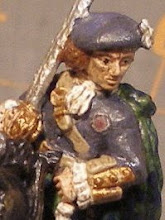While the Carpanian grenadiers deploy behind them, the two cavalry units clash. The Courland cavalry (backs to artist) initiated the charge but the Carpanian dragoons quickly countercharged. This melee would last for three turns of hacking and slashing.
While the cavalry fights it out, the Imperials reserve brigade advances towards Alt Kirchendorf. On the far side of the town, Campbell's Highlanders (in the pay of Carpania) have come out to contest the advance of the Courland grenadiers. In the foreground is the combined Sachsen-Wachsenstein and Reichsarmee grenadier battalion.
A panoramic view of the center and west end of the battlefield. In the middle distance the Courland grenadiers and the Highlanders come to point blank range while the cavalry melee continues to swirl beyond the town.
Photo by Ed Sansing
The action has now become point blank as the two lines of grenadiers exchange volleys.
Another view of the point blank firing between the Carpanians on the left and the Imperials on the right.
An aerial view of the fighting. Even though the Carpanians were taking casualties the closeness and heat of the action would prove too much for the Imperial grenadiers.
Back to the cavalry melee, with the Carpanian Braun grenadiers and the pioneers trying to get into the cavalry's action. But a volley in passing by the Reichsarmee grenadiers would cause the Carpanians to halt before they could get into the cavalry fight.
After trading volleys with the Courland grenadiers and their battalion gun, the Highlanders are reduced to below 50% strength and will soon fall back towards the town.
The Carpanian grenadiers and Campbell's Highlanders are left in undisputed control of Alt Kirchendorf, . . .
as the Imperial's reserve brigade grenadiers continue to fall back out of point blank musket range. The Imperial reserve brigade commander just couldn't get his men to go that extra little bit to overcome the Carpanian resistance.
After three turns of hacking and slashing, the Carpanian dragoons (in the distance) and the Courland cavalry (in the foreground) fall back to regroup. Both commands lost about 2/3 of their numbers in the fight. Needless to say, this ended the day for both sides' heavy cavalry.
With the cavalry melee ended and the reserve brigade's grenadiers in trouble, the Imperial army commander directs his second line brigade of Imperium and Reichsarmee troops toward the west flank.
As the fighting winds down, the Highlanders madly move back out to harry the Courland grenadiers. But fire from the Courlanders and their battalion gun quickly slaughter the hapless Highlanders.
So who won? With night falling and reports of Imperium troops advancing on the eastern border of Carpania, probably being led by Reichs Duke Wilhelm von Beerstein himself, the Electoral commander decides to fall back. Although he has stymied the Imperial attack here on Alt Kirchendorf he worries about his flanks. The second line Brittanian brigade and the light cavalry cover the withdrawal. The Imperials remain on the battlefield to recover their wounded and regroup their battered formations.
The next action will take place around the cannon foundry of Eisenmuhlen on 3 October 1759/2009. Can the Electoral forces throw the Imperials back or will they have to emulate the forces of the Grand Duchy of Stollen and fall back deeper into Carpania? We'll have to wait and see!
























































